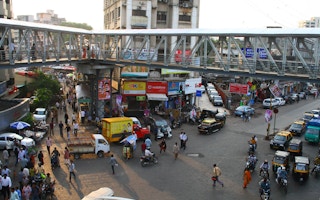“In some cities, the temperature is as much as 12°F (6.6°C) warmer … on top of a temperature that is already rising because of climate change,” said Jen Brady of Climate Central.
About 200 million urban-dwellers across more than 350 cities now experience summer temperature highs of at least 35°C (95°F), and the number of cities exposed to extreme temperatures will triple by 2050, according to the C40 Cities network.
Here is what you need to know about urban heat islands:
What exactly is an urban heat island?
From buildings to roads, urban infrastructure has been designed with materials that make cities warmer.
Unlike asphalt and concrete, vegetation including grass and trees absorb less heat and release more water into the air.
Emissions from commercial and residential buildings that use air conditioning also contribute to the heat, as do vehicles.
“
We’ve inadvertently designed many of our cities to be hot. We’ve pushed out nature – concreted our streets, built high in steel and glass.
Dima Zogheib, design lead, Arup
Heat can feel worse from one neighbourhood to another due to how the areas are designed – often having a disproportionate impact on lower-income households, research has shown.
This is because such homes are often located in densely populated areas with scarce green spaces, where families struggle to pay the energy bills needed to cool their houses.
Although nighttime should provide a respite from the heat, Arup’s study found that Cairo, London and Madrid experienced worse heat spots after the sun went down due to solar radiation getting trapped by buildings and surfaces during the daytime.
“When we have a heatwave, we’ve got several days where it’s hot,” said Dimple Rana, an environmental engineer at Arup. “If you don’t get respite at night, then that leads to more adverse health outcomes in cities.”
How deadly can urban heat be?
Exposure to urban heat islands was linked to 6,700 premature deaths in 93 European cities in 2015 - representing about 4.3 per cent of summer deaths in those cities that year - found a study published in The Lancet medical journal in January 2023.
The study found that vulnerable populations were at greater risk of dying from dehydration, cardiovascular disease, or heat stroke.
“Heat exacerbates previous (health) conditions,” said lead author Tamara Iungman, a researcher at the Barcelona Institute for Global Health.
“That’s why it has a greater impact on vulnerable populations like those with chronic illnesses, senior citizens, and newborns,” she added.
What can be done to beat the heat?
With this northern-hemisphere summer - the June-August period - being the hottest on record, experts say urgent action is needed in cities to prevent heat-related illnesses and deaths.
Iungman and her team estimated that increasing tree coverage in cities by 30 per cent would prevent at least one-third of premature deaths linked to urban heat islands during the summer.
Unlike materials like asphalt, trees help reduce heat by releasing water vapour through their leaves and providing shade.
Although planting more trees can be difficult for some cities that face obstacles such as drought and poor urban design, Zogheib of Arup said this could be remedied by taking advantage of open spaces such as roads and roundabouts.
“Trees take 50 years to grow and reach their potential. It is not only important to think on strategies to increase the number of trees, but also on how to care for the ones we already have,” said Iungman.
Other options include installing cool spaces in cities with shade and water fountains, as well as green roofs - covered in vegetation - or painting them white to better reflect sunlight.
“We need a shift of paradigm in which we start to think more about having cities for people than for cars,” said Iungman.
This story was published with permission from Thomson Reuters Foundation, the charitable arm of Thomson Reuters, that covers humanitarian news, climate change, resilience, women’s rights, trafficking and property rights. Visit https://www.context.news/.










